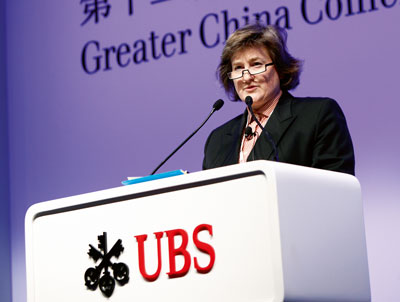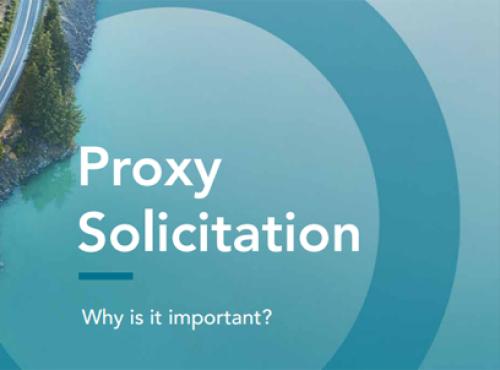UBS’ Erika Karp is a strong proponent – and living proof – of the value that ESG factors bring to companies and investors
When Erika Karp talks about diversity, the line between her personal values and professional persona doesn’t just blur, it disappears.
‘I am who I am,’ she professes. ‘I happen to be a woman. I happen to be over 40. I happen to be gay.’
She also happens to be a managing director and head of global sector research at UBS, in charge of around three dozen of the investment bank’s most senior analysts and the firm’s global investment review committee.
UBS' Erika Karp
With a wife and three young daughters, Karp is one of the financial world’s most prominent and successful lesbians, an embodiment of the power of diversity that she speaks and writes about extensively.
Since joining UBS in 1999, Karp has helped found the UBS executive diversity council (which has since been dissolved), and UBS Pride, the bank’s gay, lesbian, bisexual and transgender employee network.
She is also a senior adviser to the firm’s All Bar None women’s group and serves as the investment bank’s environmental and human rights representative to UBS’ group executive board.
Diversity, Karp points out, is ‘painful but profitable’, frankly admitting that her own personal experience has greatly informed her efforts to bring corporate sustainability from the fringes to the mainstream of UBS’ research.
Your main job at UBS is global sector research. Where does sustainability come in?
Putting a global lens on domestic issues and regional companies is now critically important, so the key senior UBS stock-covering analysts also have global responsibility. My job is to make sure they communicate, collaborate and leverage their best ideas.
I would also argue that putting an ESG lens into their research is critically important. In the same way we have to have matrix global thinking, we have to have matrix ESG thinking to do great stock research.
Where does UBS’ ESG team stand in relation to you and your global team of analysts?
Our dedicated ESG strategy team, headed by Julie Hudson in London, is extremely small – just three people. But carrying out ESG analysis in a vacuum is not the right way to go. It has to be integrated into the core of our research, not left on the periphery, and in that sense UBS is very far along.
For example, we created the UBS European ESG Analyzer in 2010 as a guide to asking the right questions about ESG factors in different industries. Now we have produced our first Global ESG Analyzer.
The starting point has to be to an industry-based analysis, and then an understanding of what ESG factors and themes are material to driving investment outcomes.
In 2011, for the first time, we built sustainability into our annual global sector outlook, which is a forward-looking analysis of where a sector is, what the big drivers in that sector are and what our preferences are.
Today ESG factors are not just about risk, they’re about growth: driving revenues, conserving costs, building brand.
A major research initiative I founded in 2002, our Q-Series (where the Q simply stands for ‘question’), has always focused on pivotal, long-term industry questions, so it has been a natural evolution to include ESG issues in the Q-Series. In 2011 and 2012, our annual Q-Series global sector conference focused on sustainability issues.
I think UBS has got it. We understand that ESG factors are fundamental, material and pivotal drivers of long-term performance. And this research cannot be done as a tangent.
IROs often complain that, despite a professed devotion to ESG issues, investors rarely inquire about them. Is there a genuine appetite among investors for the type of research you’re doing?
Companies do get asked those questions, but in a different language. Are there critical innovations that could have impact on their revenue profile? Do they have energy-efficient strategies in light of rising fuel prices? Can they attract great talent, manage staff and retain them? What risks are there on the regulatory front? What are their company’s governance capabilities?
I just asked five broad questions and did not once use the word sustainability or the term ESG. Every investor with a long-term perspective is asking these questions. My only concern is that they’re not being asked and answered as systematically as they could – and should – be.
Outside of your job at UBS, you’re a founding board member of the Sustainability Accounting Standards Board (SASB), which was launched in October 2012. Are new accounting rules and disclosures needed?
SASB is a critical element of progress in sustainable finance. Companies need to have a reasonable road map and standards for disclosure of industry-relevant information, they need assurance the data they are analyzing is good data, and they need comparability so that they and investors can start benchmarking.
There are already a number of initiatives out there and decades of work on sustainability. SASB is like a pragmatic US implementation of the Global Reporting Initiative, and it’s complementary to the work of the International Integrated Reporting Council. SASB can make enormous progress without making new rules; the laws are already in place.
The SEC says that if something is material, you must disclose it. We just need to do a better job of articulating the material impact of ESG issues, so the engine behind SASB is an industry-based materiality matrix.
Another problem SASB addresses is the fragmentation in this industry of collecting data and providing ratings. Large companies can get hundreds of requests, requiring hundreds of employee-hours to respond. That industry needs to consolidate, and it can’t consolidate effectively without standards. Standards can really be a starting point for innovation.
Is the US far behind Europe in sustainability?
European corporations aren’t fundamentally ahead in sustainability; they’re ahead in terms of consciousness-raising and a systematic integration of ESG factors, but the US is catching up.
We have the most extraordinarily diverse, innovative economy on the planet, and with our structures, cultures and management capabilities, we can offer an awful lot.
We can help companies that are already incredibly sustainable better articulate what they’re doing. SASB and Bloomberg’s ESG data are good examples of what the US can do.
Hudson and Paul Donovan, a UBS economist, wrote the book How the financial credit crunch could bankrupt the environment. Did the financial crisis put the brakes on ESG momentum?
Here’s my summary: two steps forward, one step back. Did the global credit crisis dramatically disrupt progress toward sustainability? Yes, because there was a contraction in the resources invested in it.
But in some respects we’re reaccelerating: instead of throwing financial capital at it, we’re leveraging human capital and using our brains to come up with more integrated, long-term, thoughtful solutions.
Diversity on boards of directors is an especially prominent issue in Europe just now, and it’s one of the top board-related issues for signatories to the UN’s Principles for Responsible Investment Initiative. How do companies score today in terms of diversity?
There’s a long way to go. We have evidence of more women on boards and explicit proof that diversity on boards leads to outperformance. Others argue there’s not enough proof and no causality. Yet diversity and sustainability are inextricably linked.
Real diversity is about diversity of experience, perspective, ideas and style. Innovation comes from diversity. Creativity comes from diversity. Good execution and good collaboration come from diversity.
Good boards have constructive and sometimes difficult dialogues, with directors asking each other hard questions constructively, and then pursuing them with an open mind. That comes from diversity of thought and perspective.
Looking at the long term, the evolution toward greater diversity is good and it’s powerful and we have made enormous progress. Does it take a long time for power structures to shift? Yes. Do we have enough women on boards? I don’t think so.
Will we ultimately? Yes. Is it happening as fast as I’d like to see? No, but we’re getting better. Are we seeing improvement at an accelerating rate? Yes – and that’s what keeps me optimistic.










